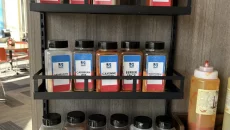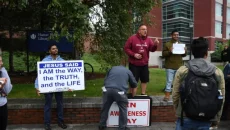Connector Contributor
UMass Lowell students have differing opinions on campus diversity.
Many student opinions surrounding diversity are intertwined with the differing ways of defining what diversity is.
Leslie Wong, director of multicultural affairs at the University, said she sees students in her office who identify as diverse based on their disability, their veteran status, as a member of the LGBT community, as an international student or as a student of color.
Wong said everyone has identities. She said that how we identify ourselves may depend on how we feel each day. In addition to our own identities, how others evaluate us plays into what makes us diverse individuals as well, she said.
When the word diversity comes to mind, many thing only of their culture as related to race. Wong said that many students come to her office thinking they do not have culture and that they are not people with a community based on their identities. Wong says this is because they are not considering the bigger picture of what makes them who they are, beyond their ancestry.
Some students echo her thoughts.
“I have a big problem with how diversity is considered,” said Nicholles Klevisha, a senior English major with a minor in digital media. “Diversity isn’t a color palette. You can’t just tic boxes and say, ‘Well this is a good representation of what we got.’ Sure, it makes for an appealing billboard or ad, but that picture focuses on the visual elements rather than the mental, and that emphasis on culture matters to me.”
Wong said the office of multicultural affairs, or OMA, works to encourage students to engage with others at the University, helping individuals in the University community to identify what they have in common with one another.
OMA has the goal of serving the campus on three levels; students on the individual level, awareness and educational level, and the larger piece of culture and climate influence on campus, she said. OMA is in contact and collaboration with 37 cultural and spiritual groups on campus, working together to host events, forums, and assist students in becoming active, said Wong.
“OMA is an organization that supports unrepresented students on campus from all aspects of life, like gender, race, ability, everything,” said Tanezsha Bostic, a senior criminal justice major and staff office assistant with OMA.
Bostic says she feels one way the campus could be more diverse is through enrollment, suggesting the University needs, “more ethnic groups.”
Klevisha said he would also like to see more diversity on campus, including but exclusively: “More queer kids of varying genders and sexualities. More people from other countries. More people with disabilities. More people who have fewer opportunities than their neighbor.”
Not all students believe the University needs more diversity, however.
“Before I came to UMass Lowell I didn’t have too many friends who came from all around the world, spoke multiple languages, and even friends who are not of the typical college age, so I definitely think it has a diverse group of students,” said Fahmina Zaman, a third semester graduate student majoring in Peace and Conflict Studies.
Not only is diversity in enrollment an aspect of the University, but diversity through education is also a part of campus life.
Wong referred this reporter to an informational brochure about the goals of, services offered by, and program highlights of OMA. This brochure outlined the goals of OMA, encouraging members of the University community to “become change agents who strive to create an equitable and inclusive environment,” often through events and student leadership opportunities.
Outside of OMA, students who attend UMass Lowell may be getting useful experience when it comes to diversity through its curriculum.
As a student in the Spring of 2015, Melissa Kiessling, took a course called Language, Literacy and Culture through the education department. Kiessling, who is attending graduate school while also working as a middle school theater arts teacher in New York, said it was a difficult course that had “moments when it felt very confrontational.”
“As a teacher now, I am very glad I took that class, especially because I teach a very diverse population,” she said.



